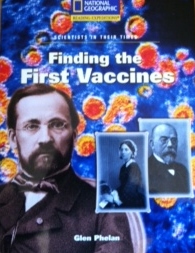Implementation 2
August 6, 2013 at 3:13 pm | Posted in P1, P2 | Leave a commentTags: EDU 6526, QAR
My school uses the Inside curriculum for Resource English. The students are given specific stories to read and discuss. There are also other books from the National Geographic series that are available to use to help students increase their reading comprehension and study skills. When and if texts are not available from core classes or if I would like to help students generalize skills to other sources, these are a good alternative to use because the format of the books mimics that of a text book, in that these books have insets with other information and pictures with captions that can be useful information to read as well as the main body of text. QAR is considered to be most useful with non-fiction texts but can be adapted to fiction as well
In the QAR approach, the teacher asks questions about the text and the students answer—this is the simplest form of the strategy. It is best to use open ended questions or questions that develop critical thinking skills. My aim is to empower my students to look at a text and ask questions before they begin to read and question while they are reading; to become inquiring readers. However, in the beginning, we will use the “From the Text” and “On My Own” method of looking for answers.
I chose to use Finding the First Vaccines, by Glen Phelan.
It is about several scientists who worked to discover vaccines. My lesson plan consists of the students pre-reading by turning the pages and looking at the captioned pictures. They will also have the questions that go along with the reading so they will know what information is important to glean from this book. I do this for these students because many of them focus on the wrong information when reading—this is just an added help to them. The pre-reading will enable them to answer one question. Next they will read for 20 minutes. I will ask the students to read the questions to be answered but wait to answer them until I stop the reading time.
At the end of the 20 minute reading time, I will ask how far students were able to read—I expect it will be through about 1/3 of the book. I will ask some discussion questions about the QAR questions and the content of the book. Some of the questions can be answered directly from the text of the book and some of the answers must be inferred from what is read. Do any of the questions make you think of more questions? Students will be asked to continue reading, until they are finished or until class is over.
The final piece of the lesson is to reflect on how pre-reading and knowing the questions before reading the text changed the way you read the text. Was it helpful to you? Would you do this again to understand material to be read?
Benefits of QAR strategy:
- It can improve students’ reading comprehension.
- It teaches students how to ask questions about their reading and where to find the answers to them.
- It helps students to think about the text they are reading and beyond it, too.
- It inspires them to think creatively and work cooperatively while challenging them to use higher-level thinking skills.
Questions:
Finding the First Vaccines
Who created the first vaccine?
Why were the skills of careful observation and attention to detail important to Luis Pasteur?
Many people thought disease was spread this way during the 1800s._______________________
What is pasteurization?
Why do think Louis Pasteur kept working after his stroke?
What did Joseph Lister do to reduce the number of his patients who died from infection after surgery?
Where did he get the idea?
How did the combined efforts of Lister and Florence Nightingale improve conditions in hospitals?
Can you think of another way that working together is better than working separately?
How did Pasteur discover how to make a vaccine?
How does a vaccine work in the body?
Can you think of other discoveries that were made by mistake?
Who was the first person vaccinated with the rabies vaccine?
What is meant by the phrase “chance favors the prepared mind?”
References:
Dell’Olio, J. M., Donk., T., (2007). Models of Teaching: Thousand Oaks, CA, Sage.
Phelan, G. (2008). Finding the First Vaccines: Washington D. C., National Geographic Society.
http://www.readingrockets.org/strategies/question_answer_relationship/
Blog at WordPress.com.
Entries and comments feeds.

